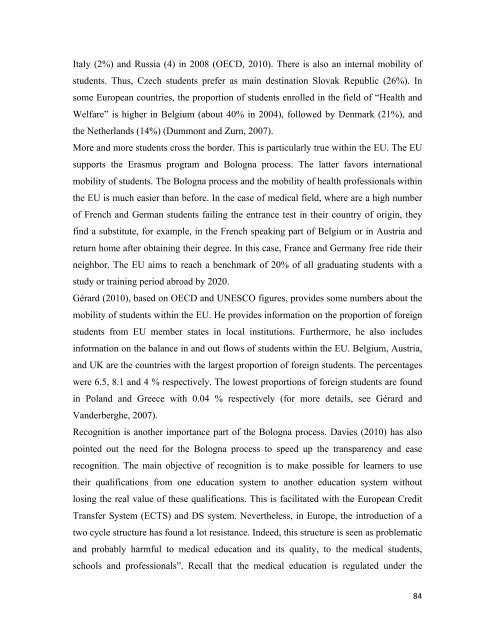Download the report - Femise
Download the report - Femise
Download the report - Femise
You also want an ePaper? Increase the reach of your titles
YUMPU automatically turns print PDFs into web optimized ePapers that Google loves.
Italy (2%) and Russia (4) in 2008 (OECD, 2010). There is also an internal mobility of<br />
students. Thus, Czech students prefer as main destination Slovak Republic (26%). In<br />
some European countries, <strong>the</strong> proportion of students enrolled in <strong>the</strong> field of “Health and<br />
Welfare” is higher in Belgium (about 40% in 2004), followed by Denmark (21%), and<br />
<strong>the</strong> Ne<strong>the</strong>rlands (14%) (Dummont and Zurn, 2007).<br />
More and more students cross <strong>the</strong> border. This is particularly true within <strong>the</strong> EU. The EU<br />
supports <strong>the</strong> Erasmus program and Bologna process. The latter favors international<br />
mobility of students. The Bologna process and <strong>the</strong> mobility of health professionals within<br />
<strong>the</strong> EU is much easier than before. In <strong>the</strong> case of medical field, where are a high number<br />
of French and German students failing <strong>the</strong> entrance test in <strong>the</strong>ir country of origin, <strong>the</strong>y<br />
find a substitute, for example, in <strong>the</strong> French speaking part of Belgium or in Austria and<br />
return home after obtaining <strong>the</strong>ir degree. In this case, France and Germany free ride <strong>the</strong>ir<br />
neighbor. The EU aims to reach a benchmark of 20% of all graduating students with a<br />
study or training period abroad by 2020.<br />
Gérard (2010), based on OECD and UNESCO figures, provides some numbers about <strong>the</strong><br />
mobility of students within <strong>the</strong> EU. He provides information on <strong>the</strong> proportion of foreign<br />
students from EU member states in local institutions. Fur<strong>the</strong>rmore, he also includes<br />
information on <strong>the</strong> balance in and out flows of students within <strong>the</strong> EU. Belgium, Austria,<br />
and UK are <strong>the</strong> countries with <strong>the</strong> largest proportion of foreign students. The percentages<br />
were 6.5, 8.1 and 4 % respectively. The lowest proportions of foreign students are found<br />
in Poland and Greece with 0.04 % respectively (for more details, see Gérard and<br />
Vanderberghe, 2007).<br />
Recognition is ano<strong>the</strong>r importance part of <strong>the</strong> Bologna process. Davies (2010) has also<br />
pointed out <strong>the</strong> need for <strong>the</strong> Bologna process to speed up <strong>the</strong> transparency and ease<br />
recognition. The main objective of recognition is to make possible for learners to use<br />
<strong>the</strong>ir qualifications from one education system to ano<strong>the</strong>r education system without<br />
losing <strong>the</strong> real value of <strong>the</strong>se qualifications. This is facilitated with <strong>the</strong> European Credit<br />
Transfer System (ECTS) and DS system. Never<strong>the</strong>less, in Europe, <strong>the</strong> introduction of a<br />
two cycle structure has found a lot resistance. Indeed, this structure is seen as problematic<br />
and probably harmful to medical education and its quality, to <strong>the</strong> medical students,<br />
schools and professionals”. Recall that <strong>the</strong> medical education is regulated under <strong>the</strong><br />
! ($!
















